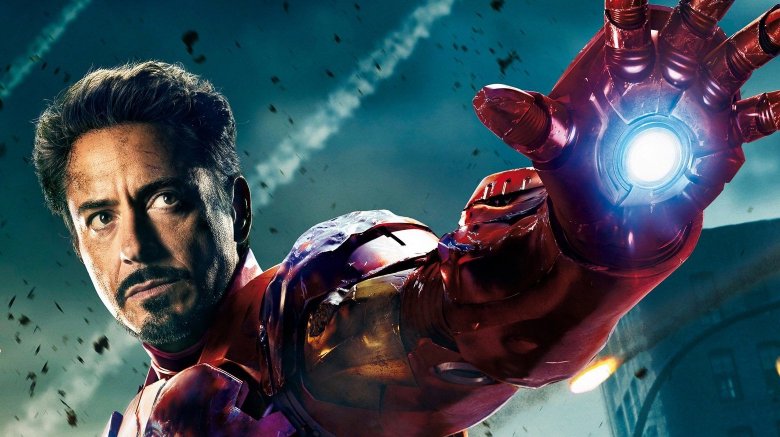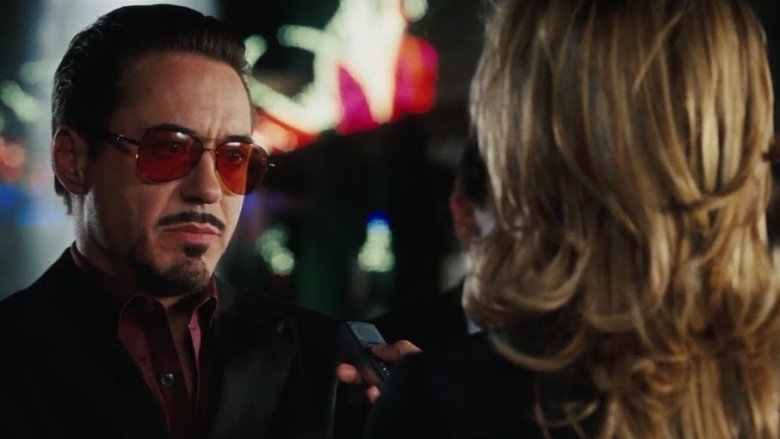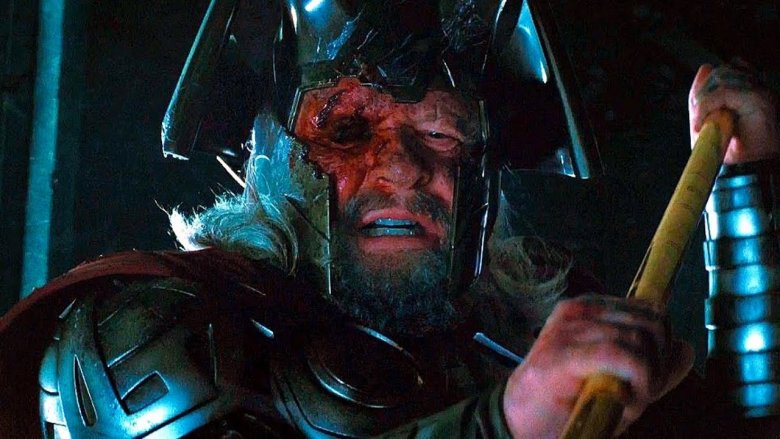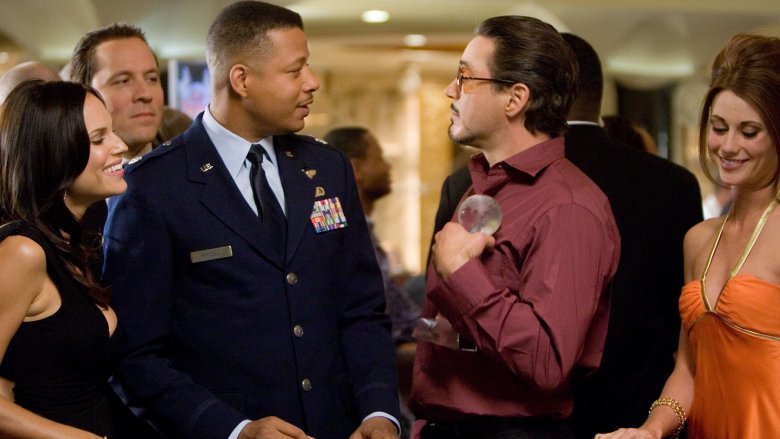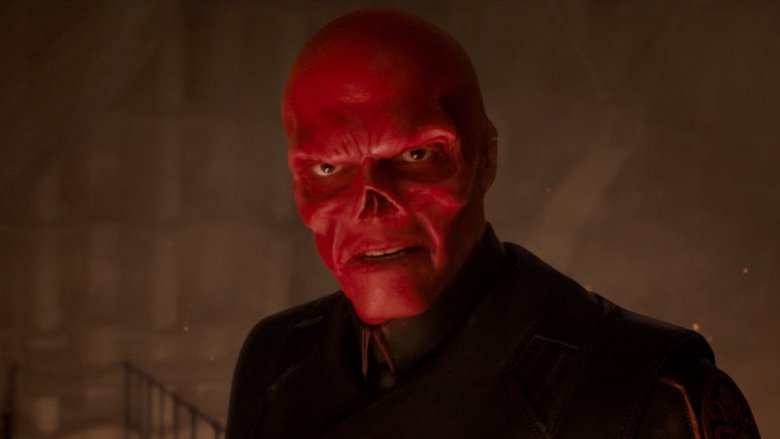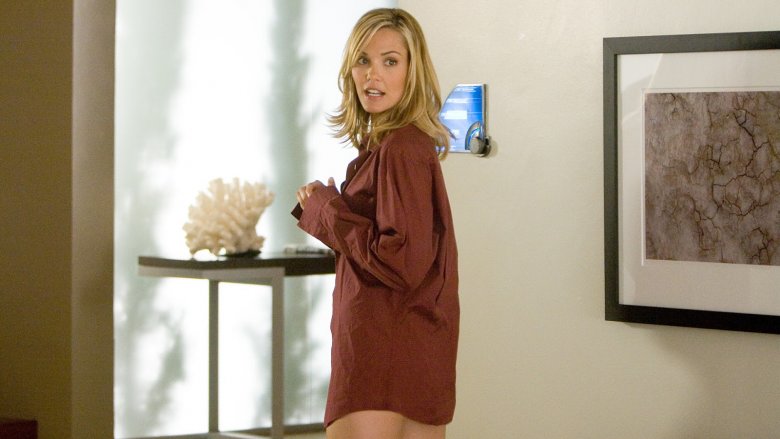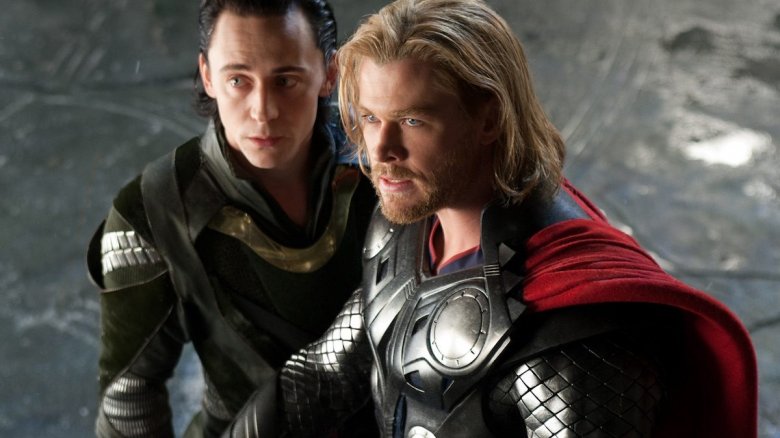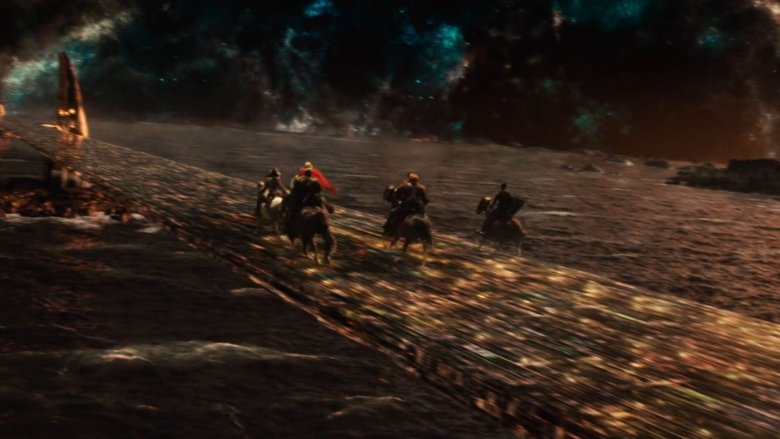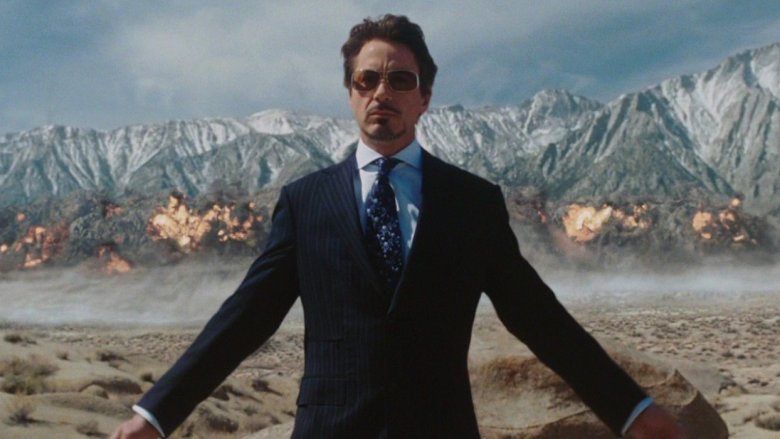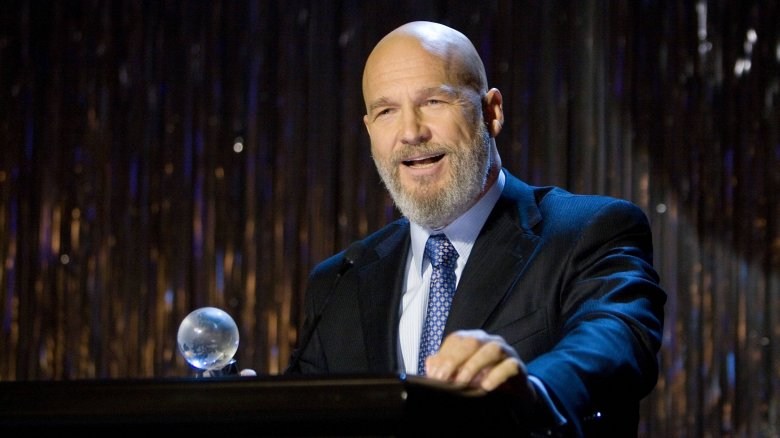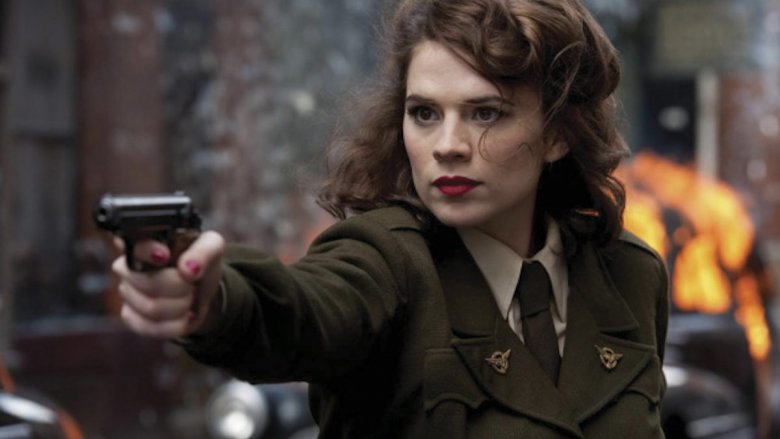Phase 1 MCU Moments That Wouldn't Fly Today
It's Marvel's world, we're just living in it. Captain Marvel dominates the box office with swagger and spunk. Black Panther was up for Best Picture. Infinity War, even a year after its debut, inspires new theories and debates every day. Superheroes are omnipresent, the average guy on the street knows what "Infinity Stones" are, and as Avengers: Endgame nears, everyone holds their breath to see who will make it out alive.
But there was a time, not so very long ago, when Marvel was new and untested. Phase 1, comprised of Iron Man, The Incredible Hulk, Iron Man 2, Thor, Captain America: The First Avenger, and Avengers, was the beginning for our intrepid heroes, and it was a lot less streamlined. We all remember Robert Downey Jr's lightning-fast zingers, sure, and who doesn't have the iconic shot of the Avengers finally assembled committed to memory? But the clunkier bits, the jokes that have aged badly, the lines that didn't quite land — those you've probably forgotten. Allow us to reacquaint you with this list.
Tony Stark's womanizing
Tony Stark burst onto the screen like one of his Jericho missiles: loud, bright, and landscape-altering. We'd had superheroes before, of course, and they had garnered fans and sequels and accolades. But Robert Downey Jr.'s Tony Stark was different. He had style, swagger, and the expertise and talent to back up his boasts. He could be a jerk, but he also advanced medical technology by decades. He was enormously full of himself, but also built himself a world-changing suit of power armor in a cave. It took him way too long to learn basic ethics, but darn it, you were cheering for him by the end. Tony Stark was not a good guy, but he was getting there, and the honesty of his journey was the key to the film's success.
But his womanizing and generally lecherous attitude towards everything feminine wouldn't work in today's MCU. His private jet includes flight attendants that double as exotic dancers. He immediately responds to a female reporter with objectifying remarks and a dismissal of her credentials. He is incapable of addressing a soldier as an equal once he learns she's a woman. Sure, there's being a lovable jerk — but then there's being outright gross. Nowadays, Tony Stark might be cocky, but he's not creepy, and he treats his female colleagues as the heroes they are.
Blatant exposition
Today, Marvel fills its universe with strangeness. A talking, trigger-happy raccoon? Sure. A man who is also a planet who is also an immortal celestial being who is also Star-Lord's dad? Why not! Obscurities like Adam Warlock get teased in the post-credits scenes, while Marvel expects the audience to keep up — and they do. When you rule the box office, you get to set the rules of engagement.
But the rules were different, once. Revisit Phase 1 and you'll be struck by just how often the movies pause to smother the viewers with exposition, making sure they've covered every informational base possible before they dive into the story. Iron Man uses an in-universe award ceremony to fill audiences in on the history of Stark Industries, Tony's lineage, and his elite status in the world of science and technology. Thor opens with a scene straight out of Tolkien, explaining the nine realms of Norse mythology, the history of the frost giants, Asgard's place as an alternate universe with some impact upon our own, and Thor and Loki's royal positions. While the MCU does still open with some degree of explanation — recall Black Panther's brief account of vibranium and the founding of Wakanda — it takes a lot less time and comes with a lot less baggage. The MCU knows you'll go home and Google for whatever you don't grasp, and accept that that's part of the fun. And nowadays? It is!
Mainstream cool
Captain America: The First Avenger stands out within Phase 1 for a few reasons, from the historical setting to the tragic end. But perhaps the most notable thing about it is how much of a misfit Steve Rogers is. This is now a defining feature of the MCU: Captain Marvel faces opposition in the Air Force and the Kree Empire alike, Ant-Man is an ex-con, and the Guardians of the Galaxy are... well, themselves.
But back in Phase 1 — especially Iron Man and Thor — mainstream success was king. Sure, Tony Stark and Thor had to be brought low before their ultimate triumph. Both were boorish, arrogant princes (literal or otherwise) who had to face down their own hubris before more conquering their foes. But even when you were wincing at their braggadocio, you were still admiring their style. Thor pulled off his red cape and winking strut from scene one, and his more ludicrous facets — like the fact that his response to enjoying a drink is smashing the glass to the floor and crying, "ANOTHER!" — are, well, still kind of endearing. As for Tony, he's a piece of work, but you can't not admire him as he melts scrap into an arc reactor and returns to his Malibu mansion through sheer tenacity and talent.
Their success as heroes — not to mention movie stars — depended on their mainstream cool. It was only later that Marvel decided to find heroism in more unlikely places.
Dramatic zooms
Superhero movies have a long history of dramatic cinematography. 1966's Batman never lost an opportunity to play around with wild angles and effects; Joel Schumacher framed his candy-colored cast in energetic, borderline bizarre ways; and Sam Raimi's Spider-Man series took the genre to new heights with its majestic, swooping shots of New York City as glimpsed from the webslinger's airborne point of view. The Marvel movies, in contrast, can seem sedate. If experimentation is required, directors seem to prefer playing with costume and set design or mind-bending special effects a la Doctor Strange.
Phase 1, however, had a few moments that bordered upon the nearly cartoonish. Thor and Iron Man in particular saw a number of dramatic zoom-ins that have vanished from every subsequent phase. The hammer! The mask! The tools! Plot-important objects are forever being pointed out by the camera, to make sure the audience understands just what the stakes are. It makes sense — early on, people really did need to learn for the first time just what makes our heroes so heroic. But to the modern MCU fan, they stick out in a way that is positively retro.
Pepper Potts "taking out the trash"
Pepper Potts has come a long, long way. One of the weirdest things about revisiting Phase 1, in fact, is reacquainting one's self with her former position as Tony's assistant and long-suffering quasi-friend. She's good at what she does and the attraction between the two is obvious from day one — from her introduction, you can see the woman that will become a heroine in her own right buried within the cynical, skirt-suited shell. But it wasn't all tartness and day-planning back in Phase 1 for the competent Ms. Potts.
Recall Tony's sleepover with the aforementioned disrespected reporter, Christine Everhart. She wakes, finds the bed empty, and encounters Pepper, who informs her that her clothes have been cleaned and pressed, and that a car is waiting to take her wherever she wants to go. A minor verbal tussle ensues, and Pepper, smiling coolly, informs Ms. Everhart that one of her responsibilities is, when necessary, "taking out the trash" — the trash, obviously, being Ms. Everhart herself. It's a line that crosses over from cutting to outright nasty and, frankly, sexist. Happily, such rhetoric would be unlikely to come from Pepper today.
A far more violent Thor
Thor loves a fight. It's one of the things that makes his character so charming — his love of battle is oddly pure. Against man, woman, or frost giant, he's ready and willing to rumble, and absolutely thrilling to watch. In tandem with his borderline-goofy personality, it makes him a lovable jock and a worthwhile leader. As Endgame nears, he's not just one of the greatest warriors poised against Thanos, but one of the greatest heroes, period.
Revisit his first movie, however, and encounter a very different Thor indeed. Here, Thor topples tables in rage and encourages his friends to do stupid things out of rash and thoughtless anger. He's an overgrown child here, eager to fight for reasons that border on cruel, and utterly unaccustomed to any sort of disobedience or true horror. He doesn't understand war yet, nor sacrifice, let alone heroism. Part of this was his character evolution, of course, but much of it is in Hemsworth's interpretation. It's clear that his understanding of the character changed as he sailed through team-ups and subsequent Thor movies, arriving, finally, at the thunder god we know and love today... minus the cup-smashing.
Horses on the Bifrost
Asgard: realm of the gods, city of warriors, place where it is still totally acceptable to wear a cloak. Part of the charm of the first Thor movie is how nakedly it embraces its aesthetic and all its trappings, from the golden helmets to the splendiferous feasts. It's all the best things about Middle-Earth and Westeros, but without the gross stable work and bubonic plague. Though much of it has been stripped away — Thor: Ragnarok was positively space-age — it's still a corner of the MCU where guns are negligible, giant wolves lope across the land, and magic is a very real force.
But you might have forgotten just how fantastical Thor is, and how much of that fantasy never made it further into the MCU. The first scene we see of heroes crossing the Bifrost finds Thor and his entourage galloping across it on horseback. Capes fly, swords glint in the sunlight, and the effect is positively medieval. Now, we don't blink at Jon Snow or Aragorn saddling up, but it is truly, honestly weird to encounter it in the MCU. No wonder as to why — now our noble adventurers just walk across the rainbow bridge like anyone else.
Rougher CG
The MCU is at a high point of computer graphics. Thanos isn't just visually convincing, he's fascinating. When he's on screen, your eyes are on him. The stakes were high for his star turn in Infinity War, as anything less could have been disastrously goofy. Imagine the sheer tonnage of Grimace and Grape Ape jokes the world could have seen. Imagine how unintentionally hilarious his scene on Vormyr might have been. Imagine, way back in the first Avengers movie, if his credits scene stinger had invoked a shocked chuckle instead of a gasp. Thanos is the crown jewel in the MCU's CG crown, and we're all lucky this ended up being the case.
Back in Phase 1, though? Things were a lot less certain. The MCU has never looked bad, exactly, but there is some truly wonky work early on. The Jericho missiles that punctuate Tony Stark's presentation to the U.S. military lack the weight of, say, the projectiles Thanos and Ebony Maw fire in Infinity War. The Bifrost in Thor is a lot less ethereal and a lot more like a light-up plank of wood. Even the Chitauri hordes swarming across New York City in Avengers look a little off, especially as compared to the fluid motion of the attack dogs released upon Wakanda's defenses in Infinity War. You could get away with that back in 2009, but it in 2019? Not so much.
Bland bad guys
No superhero worth their salt goes without a bad guy for long. The MCU is currently dominated by one right now — both on and off the screen, Thanos is all anyone's talking about. Dude wiped half of all sentient life with a literal snap of his fingers, threw his daughter off a cliff for a magic rock, and we are still debating whether or not we can completely condemn him.
Back in Phase 1, however, bad guys were... well, bad, and not much else. Sure, there was Loki, full of complex emotions about his lineage and place in Asgard (and the enormous, character-specific fandom he ended up garnering). But besides him, the villains of Phase 1 kind of blend together. They all basically want the same thing: power to do bad things. Obadiah Stane, Red Skull, the Frost Giants, the Chitauri, and Emil Blonsky all pretty much boil down to "bad dude wants the hero's power for himself." Ivan Vanko pushes at this a bit from within Iron Man 2, but he (and the rest of that movie) have largely fallen through the cracks. It took a while for the MCU to right the ship on this one — remember the dark elves from Thor: The Dark World? No, because no one does. But they did in the end, and now we get to enjoy our villains with a side of personality.
Peggy Carter calling her troops "girls"
Compared to some of the other Phase 1 movies, Captain America: The First Avenger seems squeaky-clean. The costumes are spotless. The special effects are impressive without looking uncanny. The actors balance sensitive romance alongside classic adventure and a bittersweet ending. It holds up all the way through.
Except for one thing. The First Avenger's military personnel absolutely love to motivate their troops by calling them "girls" or "ladies" in an effort to humiliate them. Most jarring of all is Agent Peggy Carter's repeated use of it, at one point even going so far as to shame the men by comparing them to her grandmother. It's not just that this lands unfortunately, especially in our modern world full of brave female soldiers — it's that today's MCU actively rebuffs it. Black Panther specifically retains an all-female royal guard. Mantis, Gamora, Scarlet Witch, and Black Widow all save the world on a regular basis. And, most prominently of all, there is now Captain Marvel: not just a female superhero, not just a female soldier (of two military forces, no less), but a woman in the Air Force who specifically takes on the kind of sexism the good guys in The First Avenger employ. Not to mention the fact that Agent Carter herself would go on to face that kind of treatment in her later TV series. The more things change in the MCU, the more woman warriors will show up and make your earlier ignorance look bad.
